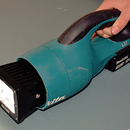Introduction: Rivnut / Nutsert Installation Tool
Rivnuts are handy little things that allow you to put a thread into sheet metal and are common in all sorts of applications. You often see them holding metal furniture together, or used in the roof of a car to hold the roof rack on. This instlation tool uses a screw that makes work easier by magnifying the force you exert on the Rivnut to crush it in the hole.
The problem is many of the installation tools are just junk and break, or are so big, they are impossible to use in a confined space. I use Rivnuts under cars and hot rods, and a large installation tool will not work inside the chassis rail or engine bay and the like.
If you have access to a lathe and a welder you can make your own indestructible tool that is also very compact to get in all those hard-to-reach places.
The instructable is very detailed with lots of photos and notes as it's
written for my beginning engineering students, who enjoy being able to work independently and at their own pace.
Step 1: Learning Intentions and Success Criteria
Learning Intentions
- To work safely in the workshop.
- To build a Rivnut installation tool using a design and instructions.
- To use hand tools correctly and safely.
- To use the lathe and MIG welder correctly and safely.
- To be a self-directed learner.
Success Criteria
- I understand the safety rules and I am working safely in the workshop.
- I can follow the instructions independently.
- I can produce a Rivnut installation tool and follow the instructions.
- I can safely use marking out tools, lathe, MIG welder and files correctly.
Step 2: Stuff You Will Need
You will need access to some tools, A metal lathe, welder, tap and die set, ruler, drills etc.
The tool itself only requires a few parts you may even find materials in the scrap bin you can use most of the sizes don't matter too much.
- Handle - just something you can hang onto. I used a 250mm of 12mm rod
- Bolt and nut - needs to be large and long with the thread all the way to the head. I used a 12mm x 50mm but anything around that size will do, 1/2 inch is very common, and will work
- Body - You will need a short piece of the solid round bar around 30mm long the diameter doesn't matter much, I used 19mm or 3/4 inch, but 25mm or 30mm would also work.
Step 3: Drilling the Body
This tool is for 8mm Rivnuts, You will have to change some of the sizes if you want to use a different size bolt or Rivnut.
If you have not used a lathe before, check with your teacher as things can go bad very quickly if you put your hand or clothing in the wrong place. You can slide show the photos and read the notes or read the instructions below or both.
- You will need around 30mm of round solid bar, which can be cut in the bandsaw or by hand.
- Mount the solid in the lathe and make sure it runs true and is tight.
- Use the center drill to drill a small pilot hole, this will keep the hole centered and stop the drill from breaking.
Drill about halfway up the tapper of the center drill
- Always use a little cutting fluid to keep the drill cool and help with cutting
- Use a 6mm drill to drill all the way through, you will need to back the drill out to clean the swarf to prevent jamming or breaking the drill.
- Next drill all the way through with an 8mm drill.
- Measure the material and transfer that measurement to the 12mm drill with a marker pen.
- With the 12mm drill you need to bore out the hole almost all the way through using the mark as a guide.
- Look out for long pieces of Swarf as it can be sharp and hot
Step 4: Facing the Body
Facing is a lathe operation that involves machining the end of the material to get it square and flat.
You can slide show the photos and read the notes or read the instructions below or both.
- The tip of the tool needs to be the same height as the center of the material you can check this with the center drill for reference
- Only use the tip of the tool never the side.
- Only machine the side nearest you never the far side.
- A triangle file can be used to debur sharp edges. care needs to be taken as you can jam the file
- Turn the material around and face the other side
Step 5: Machining the Bolt
You will need to machine the end of the bolt down to 8mm diameter the length of your Rivnut fastener, this is a little tricky, make sure the bolt and it very tight in the lathe chuck as the threads tend to push the bolt into the chuck when the tool is cutting. It can be difficult to cut the thread straight, the instructions will show you how to get the thread perfect.
You can slide show the photos and read the notes or read the instructions below or both.
- First, mark the length with a marker pen
- Wind the nut onto the bolt and mount tin the lathe chuck
- Set the digital calipers to 8mm
- Remember to set the tool to the correct height and only use the tip of the tool
- Cut a small step on the end to the correct diameter (8mm)
- You can then turn the rest of the bolt down to using the step as a guide
- Measure your work it should be close to 8mm
- Remove the drill chuck from the tailstock and move towards the work
- Use the 8mm x 1.25 die on the tailstock to start the thread this will keep it square and straight
- Do not turn on the lathe just turn the chuck by hand
- The die will have to be turned backward to remove the swarf and to prevent it jamming
- Once you have the die on 2 or 3 turns the bolt can be put in the vice.
- Turn 1/2 a turn forward and 1/4 turn back to remove swarf
- Some lubrication will help cut the tread
Step 6: Making the Handle and Testing
The handle can be made from just about anything you have lie around, I choose a piece of 12mm rod As long as it's welded on square and straight, and has no sharp edges it will work.
You can slide show the photos and read the notes or read the instructions below or both.
- Chose your handle
- File off the mill scale for a good weld and remove any sharp edges
- Set up the body and handle for welding you may have to use a spacer to get the handle to sit centered on the body
- Tack weld and check for straight and square
- Sand with scotch bright and paint.
- Some electrical heat shrink tube can be used to make the handle nicer to hang on to
- To use drill an 11mm hole in the sheet metal. Fit the Rivnut to the bolt and use 2 spanners to tighten the nut
- The Rivnut will crush and fasten to the sheet metal

Runner Up in the
Simple Machines Challenge













